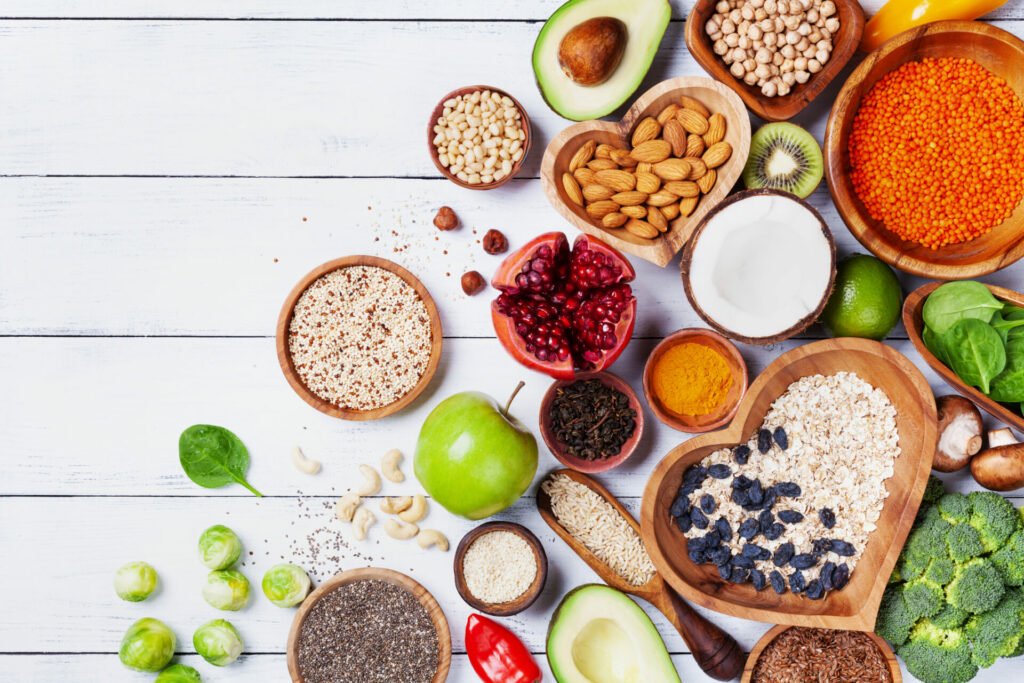Vegan Globetrotter is supported by our audience. When you purchase through one of our links, we may earn a small affiliate commission. As an Amazon Associate I earn from qualifying purchases. Your cost is not affected.
==================
Fruits Used As Vegetables
As fruits and vegetable lovers, we feel excited whenever we pass by the farm produce section of the supermarket. Almost by instinct, we pick up the ones we love: the delicious, the healthful, and the new exotic ones that catch our eyes. So, we get our favorite fruits in the fruits section, and the vegetables in the veggie section. Because fruits are fruits and vegetables are veggies. And we go on with our lives as normally as we should.
Yet, it also pays to know that plant-based foods are classified either as vegetables or fruits. Which depends on how they are used as ingredients in cooking. For example, it may be a fruit botanically. But when mostly used as a savory ingredient, it will be classified and marketed as a vegetable. In essence, they are fruits used as vegetables.
And it’s enlightening to know their true nature. It won’t diminish how we like them. Or affect how we use them as ingredients in cooking. Believe that knowing such interesting facts about them will actually make you love them more.
Now, let’s go over and learn a few eye-openers about the 15 vegetables that are actually fruits.

What fruits are
Fruit is the flowering plant’s ripened ovary and can be dry or pulpy. It also contains the seed, which can be one or many. And a fruit has two parts, the pericarp and the seed. The pericarp layer surrounds the seed and it is composed of the skin or rind, the outer layer, and the fleshy part.
There are 3 pericarp parts. The outer part is called the epicarp or exocarp which is the skin or rind of the fruit. The second is the mesocarp which is the edible flesh. And the third layer is the endocarp. It is the skin that covers the seed.
Finally at the core is the seed. It has three parts: the seed coat, the embryo, and the endosperm. The endosperm provides food or nutrients for the embryo.
For citrus fruits like an orange or lemon, it’s a bit different. The epicarp or outer layer is thicker and is called the flavedo. The mesocarp is the part that can be eaten.
What vegetables are
The vegetable is any part of a plant that is edible for humans to use as food. And it can include any part of the plant that is edible or can be cooked for human consumption. However, depending on the culture and culinary usage, it may only include savory fruits. Examples are tomatoes, broccoli, and seeds.
LIST OF FRUIT VEGETABLES
01 AVOCADO (Persea americana)

Avocado dip with basil and fresh avocado
The avocado fruit or vegetable grows on a tree, the avocado tree. Botanically, it belongs to the family of flowering plants, Lauraceae. Its fruit is also known as alligator pear and avocado pear.
Guacamole is perhaps the most popular dip made of avocado. The other ingredients include cilantro, garlic, onions, tomatoes, lime juice, and salt, all mixed in together. Then a dash of cayenne pepper is added.

A bowl of creamy guacamole with avocado, tomato, cilantro, lime and tortilla chips
Nutrients & Health Benefits:
One of the benefits of eating fruits is that most of them can be eaten raw. So, there are many ways to enjoy them. And they provide a rich source of these nutrients:
- Vitamins C
- Tocopherol or Vitamin E
- Vitamin K
- Pyridoxine or Vitamin B6
- Riboflavin
- Niacin
- Folate
And they protect the heart because it has beta-sitosterol, a natural plant sterol. It is an unsaturated steroid alcohol that works as a blood thinner, or anticoagulant. Together with other plant sterols, it keeps the heart-healthy. They aid in maintaining cholesterol levels right. Also, vitamin K induces the absorption of calcium which promotes bone health.
Lastly for eye health, avocado contains both lutein and zeaxanthin, phytochemicals that are also in our eye tissues.
02 BITTER GOURD (Momordica charantia)

Bitter gourd or bitter melon, whole, halved and sliced
Growing in certain parts of Asia, Africa, the Caribbean, and Latin America, the bitter gourd has a rind that’s covered with irregular ridges, resembling warts. And it also goes by the names bitter melon and bitter apple. There are numerous varieties of this fruit in terms of bitterness and its elongated oval shape. Also, the red arils or seed coverings of this fruit are edible but the seeds are not.
Many types of bitter gourd are grown. They are mostly differentiated by their appearance, and how they look. For instance, the Chinese bitter gourd is longer and light green rind, with the typical bumpy, wart-like texture.
As a meal ingredient, it is recommended to immerse the fruit in cold water to lessen its strong, bitter flavor. Bitter gourd is also an ingredient added to curries.

Bitter gourd fry with spices Asian style
Nutrients & Health Benefits:
Besides calories, carbs, and fiber, bitter gourd is packed with a lot of essential nutrients. Such as vitamin C, folate, potassium, zinc, and iron.
Additionally, it’s a source of antioxidants such as catechin, epicatechin, chlorogenic acid, and epicatechin. They contribute to both immunological and nutritional protection of the body such as cell damage protection.
03 Cucumber (Cucumis Sativus)

Cucumbers, whole and sliced
The cucumber plant is a creeping vine bearing oblong or cylinder-shaped fruits. And there are three varieties, each having an advantage. One is good for slicing, and the second is for pickling. The third cucumber cultivated variety is called burpless or seedless. It’s for convenience in eating cucumber with no seeds. So, food businesses like gourmet restaurants prefer them for their food fares. The dining experience is enhanced when no seeds would get in the way of enjoying a fare with cucumber.

Traditional British cucumber sandwich for afternoon tea
Nutrients & Health Benefits:
Due to cucumbers’ high percentage of water, they can be refreshing to eat on warm days and also may alleviate dehydration.
Having cucumber in our diet gives many health benefits. For one, eating them prevents stones to form in the kidneys. And constipation may also be prevented or relieved. In essence, they help maintain a healthy gut.
There’s more like the vitamin K in cucumber is good for bone health. It can help prevent cancer because of the nutrient cucurbitacins that arrest cancer cell growth. And as a source of dietary fiber, cucumber contributes to cholesterol control. In turn, it gives protection against illnesses involving the heart. Other nutrients they contain are vitamin C, magnesium, manganese, and potassium.
05 EGGPLANT (Solanum melongena)

Eggplant vegetable fruits with sliced pieces
Aubergine is its other name for eggplant. It’s the French word for the fruit and the deep purple hue. Eggplant is a berry from a botanical point of view and definition. However, it is used as a vegetable in cooking. Though its thin skin and seeds are edible, they are generally cooked than eaten raw. For people In the Mediterranean, eggplant is a staple vegetable in their diet.

Platter of grilled eggplant with rosemary
Nutrients & Health Benefits:
As a plant vegetable, eggplant contains some antioxidants such as lutein, nasunin, and zeaxanthin. They are important in the diet to help our system fight free radicals that potentially damage cells. That can lead to a host of other diseases. Moreover, its antioxidants, fiber, vitamin C, and vitamin B6 promote cardiovascular health.
Eggplants also contain polyphenols which protect the body from cancer. Also, the antioxidant nasunin helps our cognitive abilities, supports blood flow to the brain, and neutralizes neuroinflammation,
06 GREEN BEANS (Phaseolus vulgaris)

Fresh raw green beans on wooden board
Green beans come in more than 130 varieties. And they must be harvested before they ripen. So, they are young green beans as well as their cultivated varieties. They’re quite a popular food in many countries that they are marketed not only as fresh produce from the farms. They’re also available in cans or frozen, and grocery stores sell them.

Green beans with caramelized pecans and shallots
Nutrients & Health Benefits:
Vitamins A, C, and K are the vitamins green beans have most. And they’re also full of fiber and folic acid. Therefore when using canned green beans, lessen the sodium content by discarding the water content. Afterward,, rinse them with clean or tap water. Green beans provide significant amounts of calcium, iron, magnesium, phosphorus, and potassium. In smaller amounts are pro-vitamin A (beta-carotene), vitamin K, and folate.
Loaded with a lot of chlorophyll, green beans can help fight certain carcinogens. They are released when grilling meat at high temperatures. And folate can help alleviate depression and provides an adequate source of vitamin K for better bone health.
07 OKRA (Abelmoschus esculentus)

Fresh okra, whole and sliced
Also popularly referred to as gumbo and ladies’ fingers, the okra plant bears fruits simply called okra. And these fruits are actually the pods that contain seeds which we use as vegetables. Also, the pods when cut open have a sticky or glutinous substance when cooked. Interestingly, as a food it is versatile. And they may be consumed raw, or cooked, pickled, and also tossed into salads.

Okra as a vegetable ingredient
Nutrients & Health Benefits:
Okra contains most of the nutrients our body needs, such as calories, protein, carbohydrates, and fiber. They also contain vitamins A, B1 (thiamine), B6 (pyridoxine), B9 (folate), C, and K. And the minerals potassium, magnesium, calcium, and folate.
Okra’s gooey stuff can also get rid of toxins in the body. And together with the number of nutrients it gives can ward off life-threatening diseases. These are cancer, cardiovascular ailments, diabetes, gastrointestinal disorders, and osteoporosis.
08 OLIVES (Olea europaea)

Green olives in a wooden bowl with an olive branch
The olive fruit grows from the olive tree which may be a small one or a shrub. Traditionally olives are grown in all the Mediterranean countries. In Australia, California, and South Africa, they are also produced commercially. The olive fruit, besides being used as a culinary ingredient, is also grown for its olive oil which is liquid fat.
Olives have several culinary uses and are used to enhance many kinds of foods. They can be tasty appetizers or pizza toppings. You may add them to bruschettas, or toss them into pasta dishes such as spaghetti. Maybe even add some to the already ingredient-rich puttanesca.

Olives in a wooden bowl
Nutrients & Health Benefits:
Olives are a great source of dietary fiber for a healthy gut. It contributes to lowering one’s risk of developing the dreaded cancer. And it provides us with the more healthful monounsaturated and polyunsaturated fats. One of which is called oleate. What’s more, it provides a rich source of polyphenols. It’s an antioxidant that protects the health of the blood vessels and the heart. Besides carbs and fiber, olives should provide you with vitamin E, calcium, copper, iron, and sodium.
09 PEAS (Pisum sativum)

Green peas and pods
It is the ball-shaped seed of the pod fruit Pisum sativum, popularly known as a pea. There are many kinds of peas. They generally have a life span of about a year. Green is the most common pea color, and some are yellow, or purple, which is the least common. Peas are also sprouted and used as savory ingredients.
Here are some varieties of peas:
- Black-Eyed Peas
- Chickpeas
- Garden Peas
- Green Peas
- Field Peas
- Pigeon Peas
- Snow Peas
- Sugar Peas

Peas and carrot cubes
Nutrients & Health Benefits:
Peas are available fresh, canned, dried, or frozen. And they contain many beneficial nutrients. Calories, cholesterol, saturated fats, and sodium are low in many varieties making them an easy addition to many meals.
There are also a lot of good things to get from eating peas. Their glycemic index is low, so blood sugar doesn’t go up. Plus, it is a better alternative than protein from animals. Peas also is an alternative source of nonheme iron, which is healthful and found mostly in animal meat. Additionally, peas also contain antioxidants that can fight cancer.
10 SWEET CORN (Zea mays)

Sweet corns
Also known as pole corn and sugar corn, sweet corn is a variety grown as food containing a high content of sugar. It is harvested in its “milk stage” or is still unripe or immature. Usually consumed as a vegetable, it may also be enjoyed as a fruit, eaten as is straight from the cob, or cut into big pieces along its length.
Sweet corn is a large grain plant and the stalk grows ears of corn. They hold several seeds or kernels which contain edible starch.

A creamy hotpot of veggies including sweet corn
Nutrients & Health Benefits:
Sweet corns are rich in vitamin B1 (thiamine) which promotes healthy nerves and cognitive abilities. And vitamin B3 (niacin) increases the “good” cholesterol in the body which strengthens the cardiovascular system. Vitamin B5 (pantothenic acid) is also present which helps metabolize carbohydrates, lipids, and protein.
Healthy vision is also a benefit of eating sweet corn. Because it contains provitamin A which is converted to beta-carotene. The immune system and the mucous membranes are also strengthened.
11 SWEET PEPPER (Capsicum annuum)

Colored bell peppers
Also popularly called bell peppers, what’s so cool about them is their variety of colors. Red, yellow, orange, and green are the more common colors. The red ones are the green ones that have ripened. Other varieties are brown, lavender, purple, and white bell peppers. So, they not only add texture and flavor but also strong colors to a recipe. The exotic-sounding paprika is the powdered spice of dried and ground red pepper.

Bruschetta with roasted bell pepper, capers, and basil
Nutrients & Health Benefits:
Bell peppers belong to the nightshade family of plants. Their different stages of ripeness account for their difference in colors. Though they all have nutrients, the red peppers are riper than the rest. And they contain more antioxidants. Having high vitamin C content, bell peppers are beneficial in many ways to our body. The antioxidants free radicals in the body, lowering the risk of oxidative-induced diseases such as cancer. They’re beneficial to the immune system and for the body’s protein metabolism.
12 SUMMER SQUASH (e.g. Zucchini) (Cucurbita pepo)

Young sliced zucchini
Summer squash does not refer to a particular squash but a catchall or generic term under which several types, like the zucchini fruit, belong. And they are harvested when still unripe, or immature. It is when the rind is still tender, and therefore edible and just right for consumption. A few things distinguish them from the winter squashes. One is that summer squashes have a shorter shelf-life. In contrast, the winter squashes have a longer one. Another is that most winter squashes tend to form a bushy growth pattern. While many winter squashes, being vines, creep, sprawl, and meander.

Summer squash frittata with goat cheese and arugula
Nutrients & Health Benefits:
Let’s look into the benefits of zucchini, a fruit under the summer squash. It is a versatile fruit used as a vegetable that can be included in many kinds of diets. In the strictest vegan diet, vegetarian, keto, paleo, pescatarian, and omnivorous diets. And zucchini contains provitamin A, vitamins B9 (folate), C and K, manganese, and potassium.

Round zucchini stuffed with vegetables and rice
As it is high in antioxidants, zucchini can help promote a healthful degree of free radicals and health benefits. So, it protects an individual from cardiovascular disease, forms of cancer, eye diseases, and skin disorders.
Too much carbohydrates can result in high blood sugar levels. So, a diet that’s low in carbs, like substituting zucchini for high-carbs food, should bring sugar levels down to an acceptable level.
The heart and blood circulation can also benefit from eating zucchini because it is high in fiber and potassium, such as the fiber pectin which is water-soluble.
13 TOMATILLO (Physalis philadelphica)

Tomatillos on a wooden board
Also called Mexican husk tomato and Mexican ground cherry, the tomatillo belongs to the nightshade family of flowering plants. The fruits are small, round-shaped, with thin ridges running along the sides vertically. The rind color ranges from light yellow-green to yellow, and some purplish-green. Interestingly, the history of the tomatillo which originated from Mexico goes all the way back to the Aztec civilization that flourished millions of years ago.

Freshly cut tomatillo slices in a bowl with cilantro
Nutrients & Health Benefits:
Tomatillos have vitamins A and C, potassium, and smaller doses of sodium and other micronutrients. And because vitamins A and C are also antioxidants, eating tomatillos can help normalize blood pressure, promote heart health, and fight free radicals.
Being a plant, it’s full of dietary fiber that promotes gut health. And preventing cancer is possible because it contains not only provitamins A and C, but also a group of steroids called “withanolides.” All three work together to stop oxidative stress caused by free radicals.
14 TOMATO (Solanum lycopersicum)

Tomato with basil
The tomato plant bears the tomatoes. And they come in different sizes due to their cultivated varieties.
In reality, the tomato is a fruit from a botanical standpoint. It is a berry specifically. However, in cooking, it is used mainly as a vegetable. It is an important ingredient in many kinds of dishes. Such as in a viand or main course, salads, side dishes, and as a garnish in sandwiches. In juices and drinks, the tomato is also an ingredient.

Tomato Juice and Fresh Tomatoes with Basil
Nutrients & Health Benefits:
The tomato berry provides fiber and a modest amount of vitamin C. Besides water and lycopene, it is a good source of carbohydrates, about 1 percent of fat and protein.
As tomatoes are a great source of vitamin C and antioxidants, they combat free radicals which cause cancer. For blood pressure, tomatoes’ potassium content unclogs arteries resulting in ideal, normal blood pressure.
The tomatoes’ fiber content, vitamin C, choline, and potassium promote cardiovascular health.
Lastly, we all want to have clear and healthy eyes. They are important to enjoy life and be productive. So, include more tomatoes in your diet as they contain beta-carotene, lutein, and lycopene. These nutrients protect the eyes from macular degeneration, eye damage induced by light, and from developing cataracts.
15 WINTER SQUASH (e.g. Butternut) (Cucurbita

Butternut squash
Winter squash is the catchall term or generic name covering several kinds of squash such as acorn squash, butternut squash, field pumpkin, spaghetti squash, and turban squash. It’s an annual plant, that is, its life cycle is about a year.
When a winter squash matures, the rind becomes hard, and the seeds mature. It is then harvested and becomes edible as food. Generally, the winter squash is cooked before being consumed and the skin is normally not eaten.

Butternut squash
Nutrients & Health Benefits:
Fruits eaten as vegetables like butternuts lower the chance of suffering from diabetes, heart ailment, and obesity. They can lower and prevent high blood pressure due to their high potassium content. Fearsome cancer can also be lowered by getting enough carotenoids including beta-carotene.
And since fruits provide high fiber content which lowers blood sugar levels, type 1 diabetes can be prevented. More fiber lowers sugar, insulin, lipids levels, which will benefit type-2 diabetes patients.
Contains carbohydrates, protein, vitamin C, vitamin B6, vitamin E, provitamin A carotenoid (beta-carotene), and potassium. And it has fiber, potassium.
In essence
Fruits used as vegetables, or even the leaves, flowers, or roots are simply prepared and cooked as we would real vegetables. They are still fruits botanically but are prepared and cooked as vegetables for savory meals and recipes. What’s important is the nutrients we get from eating them, and the pleasure of enjoying them as savory ingredients and as fruits in a fruit salad or fruit shakes.
READ MORE:





I love the vegetables listed!
Yes, they do offer incredible flavors and nutrition!